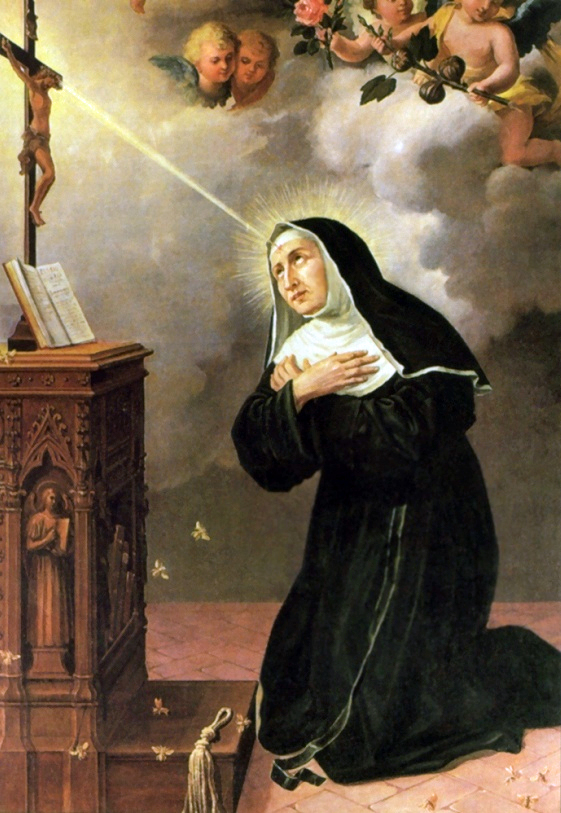The Face of Our Savior
Cascia, Italy - 1330
Feast Day - Corpus Christi
About 60 miles north of Rome, in the mountains of the Umbrian Valley, is the small town of Cascia, Italy. This town is known for two great things, it was the home of Saint Rita of Cascia and a Eucharistic Miracle.

Saint Rita
Saint Rita, like Saint Jude, is the patron saint of the impossible. Born with the name of Margherita Lotti in 1381 in the city of Roccaporena she longed to be a nun. Her parents thought it best for her to marry. She married and had two sons. Her husband was murdered and her sons vowed revenge. Margherita prayed that her sons would not be able to seek vengeance and her prayers were answered. Maybe not the way she had hoped. Her sons died of influenza before they were able to commit murder and revenge. Margherita then negotiated peace between her family and the family who had murdered her husband. In Italy in the 14th century this was considered impossible. With God all things are possible.
Margherita was given the gift of the Stigmata of the Crown of Thorns and became an Augustinian nun taking the name of Rita. Many times when one is given the Gift of the Stigmata, the smell of their wound gives of a pleasant fragrance. In the case of Rita her Stigmata gave off a putrid smell. A smell so bad that her fellow sister required her to live away from them. For 15 years she lived segregated from her sister nuns.
Saint Rita died May 22, 1457. At the moment of her death her Stigmata was replaced with a ruby red spot that gave off a delightful fragrance.

Today her incorrupt body lies in a glass casket in the Chapel of Saint Rita in the Upper (Major) Basilica of Saint Rita in Cascia, Italy. After 550 years not only is the body of Saint Rita beautifully preserved by Our Lord but her habit and veil are also in wonderful condition.

Eucharistic Miracle
The first stone of the Basilica of Santa Rita in Cascia was laid on June 20, 1937 and it was elevated to a Basilica by Pius XII August 1, 1955.
The Eucharistic Miracle is kept in the lower (minor) Basilica of Saint Rita.
In 1330, a priest in Cascia was called to administer the Holy Eucharist to an ailing farmer of the town. Instead of placing the Consecrated Host in a pyx, the priest, for whatever reason, placed the Host between the pages of his breviary. When he opened the book to take out the Host he found that the Host had turned red with fresh blood and saturated the two pages between which It was placed.
Realizing that he had desecrated the Eucharist the priest went to Siena to the Augustinian Priory to ask counsel of Fr. Simon Fidati. Fr. Simon now Blessed Simon Fidati gave him absolution. Knowing that this was a miracle, he took the two pages to reserve them for veneration at the Augustinian Monastery of Cascia.
In 1930, six hundred years after the Eucharistic Miracle, the pages were given a beautiful new Monstrance to hold Them. Once the Church of Saint Rita was completed the Eucharistic Miracle was moved from the Augustinian monastery to the lower chapel in the Church of Saint Rita.
Over the years a secondary miracle took place on the Bloodstained pages. A face began to take shape on each page. Both pages now portray a perfectly formed profile of a man with a beard.
The Basilica of Saint Rita is located at Viale Santa Rita 06043 Cascia, Italy.
Though this is a Eucharistic Miracle. We witness a Eucharistic Miracle during the Consecration every time we attend Mass.
For devotional items related to the Catholic Church, please visit Lynn's Timeless Treasures.
Index of Eucharistic Miracles
_____
Holy Card of Saint Rita of Cascia
Tomb of Saint Rita at the Basilica of Saint Rita in Cascia - Wikipedia
Photo of the Basilica of Saint Rita in Casica from Bella Umbria
Painting of The Madonna delle Libere by Pier Paolo Agabiti depicts Blessed Simon of Cascia and Saint Rita of Cascia with Mary and the Child Jesus - Painting at the Monastery of
Saint Rita of Cascia.
Picture of Eucharistic Miracle in Monstrance - The Eucharistic Miracles of the World (January 2009), p. 110.
.



s%2B-%2BCopy.jpg)

%2B-%2BCopy.JPG)
.JPG)

.JPG)




















